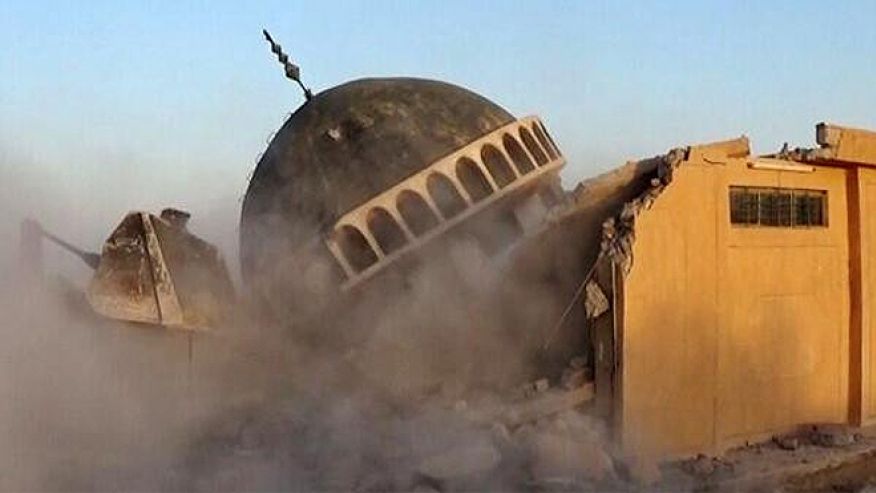Militants sever the ties that connect the region to the world—and history
by Amy E. Schwartz
In 2010, Bonnie Burnham, president of the World Monuments Fund, paid a visit to historic Aleppo, Syria to see the triumphant conclusion of a 10-year restoration and conservation of the historic citadel.
“Aleppo was bursting with optimism,” she recalled in New York recently at a press conference to highlight the ghastly cultural destruction that, along with human carnage, has overtaken the region since. “Palaces were being reopened as luxury hotels. Tour operators were signing contracts with international vendors, caterers, shopping centers.
“For now,” she added, stating the obvious, “those dreams are on hold.”
Destruction of cultural heritage—of which the obliteration of Aleppo’s old city, minaret and Great Mosque since 2012 is only one tragic example—has been a shocking subtext of the violence crashing over Syria and Iraq. While Aleppo’s citadel fell victim to what one might call the ordinary collateral damage of the Syrian civil war, the sweep of the Islamic State or ISIS across the region has brought a more extreme and intentional form of cultural destruction.

The Sunni Islamic militants, who now control large swaths of Syria and Iraq, are destroying beloved monuments and irreplaceable antiquities, both as a terror tactic and as an extension of their radical political vision. Blowing up people’s shrines wipes out local identity and severs the connection to the past, destroying any evidence of a multi-ethnic heritage. Major acts of destruction are announced in advance and videos placed gleefully online, as with the beheadings of hostages. Non-Muslim and pre-Muslim shrines, like non-Muslim communities, have been deliberately targeted. Any evidence of common ground or peaceful coexistence with other religions is anathema.
ISIS didn’t invent this baleful take on culture—ancient armies practiced it as a matter of course. The most egregious recent offenders were the Taliban in Afghanistan, who, in 2001, dynamited the gargantuan sixth-century cliffside Buddhas of Bamiyan—after announcing their intention and ignoring a storm of international pleading. But the ISIS campaign is far wider, and it’s taking place in what used to be called the cradle of civilization, a diverse, ancient, complex and heritage-rich part of the world.
ISIS “is not only beheading individuals, it is tearing at the fabric of whole civilizations,” Secretary of State John Kerry said in September, adding that the damage amounts to “one of the most tragic and outrageous assaults on our human heritage in our lifetimes.” Kerry, too, spoke at the news conference hosted by the State Department and UNESCO at New York’s Metropolitan Museum of Art, an event designed to catch the attention of international dignitaries (in town for the United Nations session). The event was deliberately set in the museum’s fabled Temple of Dendur, the Egyptian temple saved from destruction during construction of the Aswan Dam by a then-unprecedented international effort and presented to the United States in gratitude for its part in the undertaking.
Tweet this: ISIS Commits Cultural Genocide ow.ly/DOHcI
But though Kerry pledged that the United States would “focus like a laser beam” on fighting the destruction, an array of speakers couldn’t help revealing the pitiful futility of such efforts, especially in wartime. Heroic acts of heritage preservation do happen, but the most successful are usually undertaken before war breaks out (the removal of treasures to vaults, or the famous spiriting away of the Sarajevo Haggadah by a Muslim curator) or after it’s over (the painstaking reconstructions of historic Dresden, Warsaw and Dubrovnik). If we can’t even react with more than helpless rage to the videotaped beheading of actual human beings, what are we realistically supposed to do when we see a bulldozer topple a 2,800-year-old Assyrian lion?
At the Metropolitan Museum of Art, people discussed ongoing efforts to add “heritage protection” to U.S. military training, or create a “cultural counterpart to the Red Cross.” The State Department and the International Council of Museums have helped update and distribute existing “red lists” of the most threatened and significant cultural treasures in Syria and Iraq, which warn how to spot objects that have been looted when they come up for sale in international art markets.
Such efforts were designed for wars that, while not intentionally destructive to public monuments, sparked antiquities looting and decimated museums and archaeological sites. But they offer little protection against deliberate large-scale damage. Some authorities even warn that the “red lists” could be counterproductive: Pinpointing what sites are most valuable may help ISIS locate them, or, since shocking the civilized world is the whole point, move them up on the list of targets.
And rebuilding later—though probably the only feasible solution—is a poor one for the very reason these places are targets: They embody a history and culture that is complicated, many-faceted—and poorly understood. Some of the worst destruction besides Aleppo has been in Mosul in northern Iraq. But few casual consumers of the news could have told you, before destruction cast its spotlight, that Mosul boasted an 8,000-year history, a millennium of Muslim-Christian-Jewish interaction, or that it was identified with the biblical Nineveh. The destruction in one week in July of three venerable shrines including the 13th-century tomb of the prophet Younis, or Jonah, a rare joint Christian-Muslim site, drew attention to that rich history—too late.
Later the same week, when ISIS militants came to lay explosives around the city’s famed Leaning Minaret from 1172, the beleaguered inhabitants of Mosul formed human chains and, at considerable risk, faced them down. It was a wordless demonstration of what international cultural bureaucracies struggle to express. People understand the value of historical memory. They will fight for it when they can, especially when the alternative is extremism’s blank slate.

